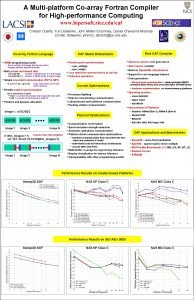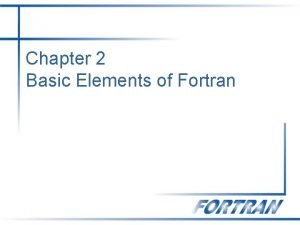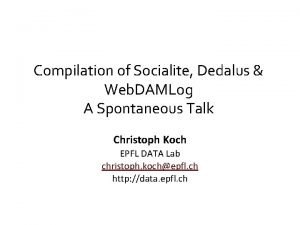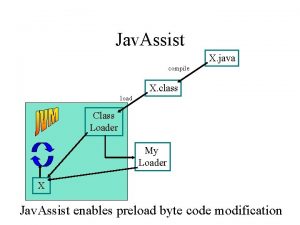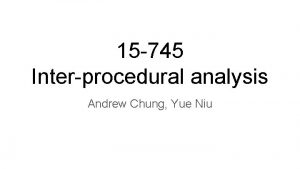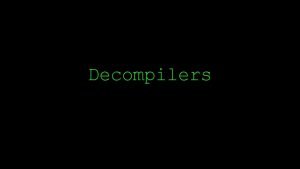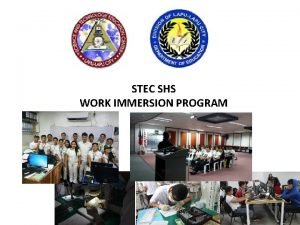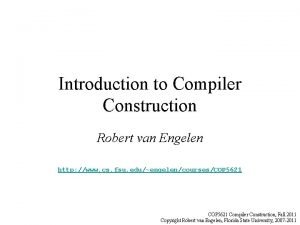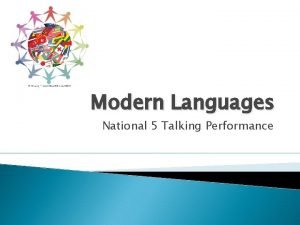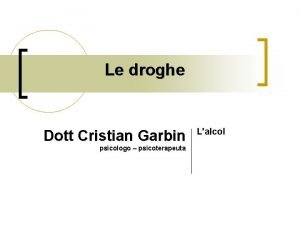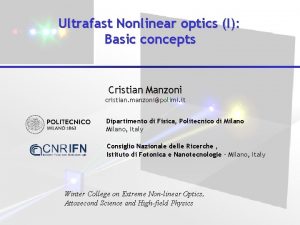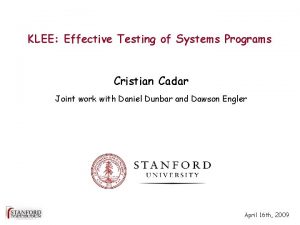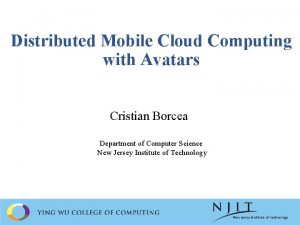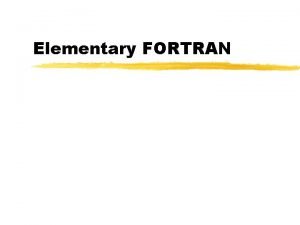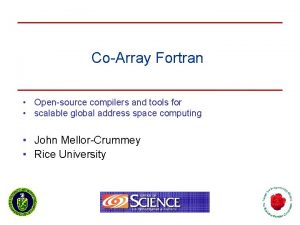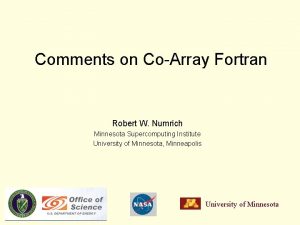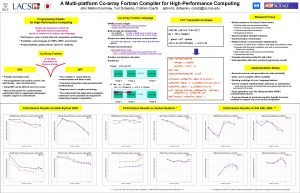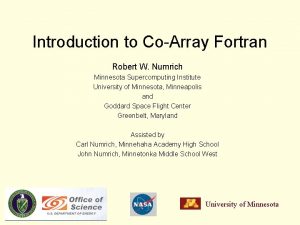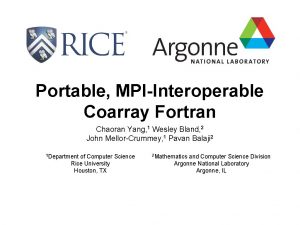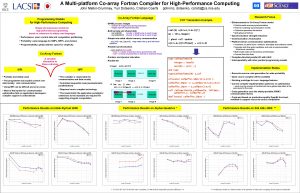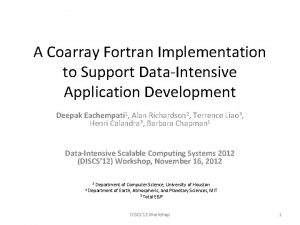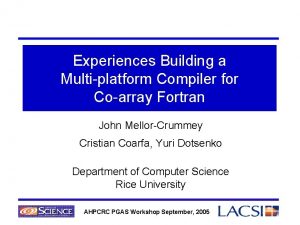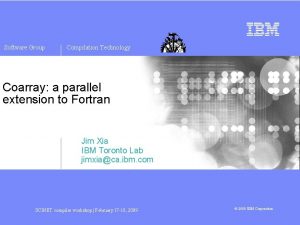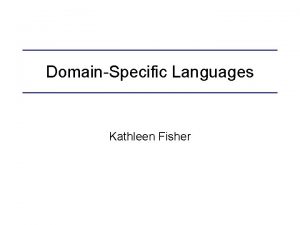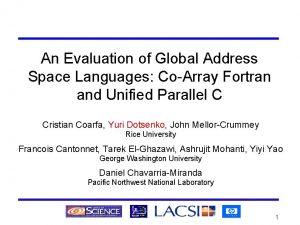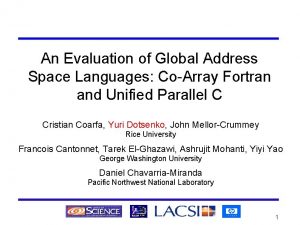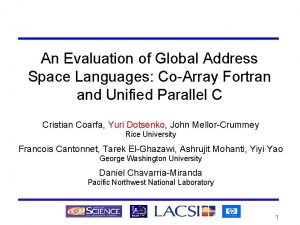Coarray Fortran Compilation Performance Languages Issues Cristian Coarfa











![Implementing Communication • Given a statement • X(1: n) = A(1: n)[p] + … Implementing Communication • Given a statement • X(1: n) = A(1: n)[p] + …](https://slidetodoc.com/presentation_image_h2/105c22dbcc3978ef8d61a3b4fd8d4dcb/image-12.jpg)



![Coming Attractions • Allocatable co-arrays REAL(8), ALLOCATABLE : : X(: )[*] ALLOCATE(X(MYX_NUM)[*]) • Co-arrays Coming Attractions • Allocatable co-arrays REAL(8), ALLOCATABLE : : X(: )[*] ALLOCATE(X(MYX_NUM)[*]) • Co-arrays](https://slidetodoc.com/presentation_image_h2/105c22dbcc3978ef8d61a3b4fd8d4dcb/image-16.jpg)


















- Slides: 34

Co-array Fortran: Compilation, Performance, Languages Issues Cristian Coarfa Yuri Dotsenko John Mellor-Crummey Department of Computer Science Rice University

Outline • Co-array Fortran language overview • • Rice CAF compiler A preliminary performance study Ongoing research Conclusions 2

Co-array Fortran (CAF) • Explicitly-parallel extension of Fortran 90/95 • defined by Numrich & Reid (see www. co-array. org) • Global address space SPMD parallel programming model • one-sided communication • Simple, two-level memory model for locality management • local vs. remote memory • Programmer control over performance critical decisions • data partitioning • communication • Suitable for mapping to a range of parallel architectures • shared memory, message passing, hybrid, PIM 3

CAF Programming Model Features • SPMD process images • fixed number of images during execution • images operate asynchronously • Both private and shared data • real x(20, 20) a private 20 x 20 array in each image • real y(20, 20) [*] a shared 20 x 20 array in each image • Simple one-sided shared-memory communication • x(: , j: j+2) = y(: , p: p+2) [r] copy columns from p: p+2 into local columns 4

image 1 image 2 image N 5

CAF Programming Model Features • Synchronization intrinsic functions • sync_all – a barrier and a memory fence • sync_mem – a memory fence • sync_team([notify], [wait]) • notify = a vector of process ids to signal • wait = a vector of process ids to wait for, a subset of notify • Pointers and (perhaps asymmetric) dynamic allocation • Parallel I/O 6

CAF Language Assessment Strengths • data movement and synchronization as language primitives • amenable to compiler optimization • offloads communication management to the compiler • choreographing data transfer • managing mechanics of synchronization • gives user full control of parallelization • array syntax supports natural user-level vectorization • modest compiler technology can yield good performance • more abstract than MPI better performance portability Weaknesses • user manages partitioning of work • user specifies data movement • user codes necessary synchronization 7

Outline • Co-array Fortran language overview • Rice CAF Compiler • A preliminary performance study • Ongoing research • Conclusions 8

Compiler Goals • Portable, open-source compiler • Multi-platform code generation • High performance generated code 9

Compilation Approach Source-to-source Translation • Translate CAF into Fortran 90 + communication calls • Benefits • wide portability • leverage vendor F 90 compilers for good node performance • One-sided communication layer • • strided communication gather/scatter synchronization: barriers, notify/wait split phase non-blocking primitives Today: ARMCI: remote memory copy interface (Nieplocha @ PNL) 10

Co-array Data • Co-array representation • F 90 pointer to data + opaque handle for communication layer • Co-array access • read/write local co-array data using F 90 pointer dereference • remote accesses translate into GET/PUT calls • Co-array allocation • storage allocation by communication layer, as appropriate • on shared memory hardware: in shared memory segment • on clusters: in pinned memory for DMA access • dope vector initialization using CHASM (Rasmussen @ LANL) • set F 90 pointer to point to externally managed memory • collect co-array initializers at link time: global initializer • call global initializer at program launch 11
![Implementing Communication Given a statement X1 n A1 np Implementing Communication • Given a statement • X(1: n) = A(1: n)[p] + …](https://slidetodoc.com/presentation_image_h2/105c22dbcc3978ef8d61a3b4fd8d4dcb/image-12.jpg)
Implementing Communication • Given a statement • X(1: n) = A(1: n)[p] + … • A temporary buffer is used for off processor data • invoke communication library to allocate tmp in suitable temporary storage • dope vector filled in so tmp can be accessed as F 90 pointer • call communication library to fill in tmp (GET) • X(1: n) = tmp(1: n) + … • deallocate tmp • Optimizations • Co-array to co-array communication: no temporary storage • On shared-memory systems: direct load/store 12

Porting to a new Compiler / Architecture • Synthesize dope vectors for co-array storage • compiler/architecture specific details: CHASM library • Tailor communication to architecture • design supports alternate communication libraries • status • today: ARMCI (PNL) • ongoing work: compiler tailored communication – direct load/store on shared-memory architectures • future – other portable libraries (e. g. GASnet) – custom communication library for an architecture 13

14

Supported Features • Declarations • • • co-objects: scalars and arrays COMMON and SAVE co-objects of primitive types COMMON blocks: variables and co-objects intermixed co-objects with multiple co-dimensions procedure interface blocks with co-array arguments • Executable code • array section notation for co-array data indices • local and remote co-arrays • co-array argument passing • co-array dummy arguments require explicit interface • co-array pointer + communication handle • co-array reshaping supported • CAF intrinsics • Image inquiry: this_image(…), num_images() • Synchronization: sync_all, sync_team, synch_notify, synch_wait 15
![Coming Attractions Allocatable coarrays REAL8 ALLOCATABLE X ALLOCATEXMYXNUM Coarrays Coming Attractions • Allocatable co-arrays REAL(8), ALLOCATABLE : : X(: )[*] ALLOCATE(X(MYX_NUM)[*]) • Co-arrays](https://slidetodoc.com/presentation_image_h2/105c22dbcc3978ef8d61a3b4fd8d4dcb/image-16.jpg)
Coming Attractions • Allocatable co-arrays REAL(8), ALLOCATABLE : : X(: )[*] ALLOCATE(X(MYX_NUM)[*]) • Co-arrays of user-defined types • Allocatable co-array components • user defined type with pointer components • Triplets in co-dimensions A(j, k)[p+1: p+4] 16

17

Outline • Co-array Fortran language overview • Rice CAF Compiler • A preliminary performance study • Ongoing research • Conclusions 18

A Preliminary Performance Study • Platforms • SGI Altix 3000 (Itanium 2 1. 5 GHz) • Itanium 2+Quadrics QSNet II (Elan 4, Itanium 2 1. 5 GHz) • SGI Origin 2000 (Mips R 12000) • Codes • NAS Parallel Benchmarks (NPB) from NASA Ames • CAF STREAM benchmark 19

NAS Parallel Benchmarks (NPB) 2. 3 • Benchmarks by NASA Ames • 2 -3 K lines each (Fortran 77) • Widely used to test parallel compiler performance • BT, SP, MG and CG • NAS versions: • NPB 2. 3 b 2 : Hand-coded MPI • NPB 2. 3 -serial : Serial code extracted from MPI version • Our version • NPB 2. 3 -CAF: CAF implementation, based on the MPI version 20

NAS BT Efficiency (Class C, size 1623) Lesson • Tradeoff: # buffers vs. synchronization • more buffers = less synchronization • less synchronization improved performance 21

NAS SP Efficiency (Class C, size 1623) Lesson • Inability to overlap communication with computation in procedure calls hurts performance 22

NAS MG Efficiency (Class C, size 5123) Lessons • Replacing barriers with point-to-point synchronization can boost performance 30% • Converting GETs into PUTs also improved performance 23

NAS CG Efficiency (Class C, size 150000) Lessons • aggregation and vectorization are critical for high performance communication • memory layout of buffers and arra might require thorough analysis an optimization 24

CAF STREAM benchmark • Derived from STREAM • Synthetic benchmark • Measures sustainable memory bandwidth and computation rate for small kernels • CAF STREAM • • Copy, Scale, Add, Triad Local and remote get versions Fine- and coarse-grain access Aim: determining the most efficient representation for co-arrays on particular platforms 25

CAF STREAM * * Results as of 07/20/2004 26

CAF STREAM * * Results as of 07/20/2004 27

CAF STREAM * * Results as of 07/20/2004 28

Experiments Summary • To achieve high performance with CAF, a user or compiler must • vectorize (and perhaps aggregate) communication • reduce synchronization strength • replace all-to-all with point-to-point where sensible • overlap communication with computation • convert GETS into PUTS where gets are not a h/w primitive • consider memory layout conflicts: co-array vs. regular data • generate code amenable for back-end compiler optimizations • CAF language: many optimizations possible at the source level • Compiler optimizations NECESSARY for portable coding style • might need user hints where synchronization analysis falls short • Runtime issues • Register co-array memory for direct transfers where necessary 29

Outline • Co-array Fortran language overview • Rice CAF Compiler • A preliminary performance study • Ongoing research • Conclusions 30

CAF Language Refinement Issues • Overly restrictive synchronization primitives • add unidirectional, point-to-point synchronization • rework model for user-defined teams • No collective operations • leads to home-brew non-portable implementations • add CAF intrinsics for reductions, broadcast, etc. • Blocking communication reduces scalability • user mechanisms to delay completion to enable overlap? • Synchronization is not paired with data movement • synchronization hint tags to help analysis • synchronization tags at run-time to track completion? • Relaxing the memory model for high performance • enable programmer to overlap one-sided communication with procedure calls 31

CAF Compiler Research Directions Aim for performance transparency • Compiler optimization of communication and I/O • optimize communication • communication vectorization and aggregation • multi-mode communication: direct load/store + RDMA • transform from one-sided to two-sided communication • transform from get to put communication • optimize synchronization • synchronization strength reduction • exploit split-phase operations for overlap with computation • combine synchronization with communication • collective communication • put with flag • platform-tailored optimization • Interoperability with other parallel programming models • Optimizations to improve node performance 32

Conclusions • Tuned CAF performance is comparable to tuned MPI • even without compiler-based communication optimizations! • CAF programming model enables source-level optimization • communication vectorization • synchronization strength reduction • achieve performance today rather than waiting for tomorrow’s compilers • CAF is amenable to compiler analysis and optimization • significant communication optimization is feasible, unlike for MPI • optimizing compilers will help a wider range of programs achieve high performance • applications can be tailored to fully exploit architectural characteristics • e. g. , shared memory vs. distributed memory vs. hybrid 33

Project URL http: //www. hipersoft. rice. edu/caf 34
 Coarray fortran tutorial
Coarray fortran tutorial Coarray fortran tutorial
Coarray fortran tutorial Compilation
Compilation X jav
X jav Previous ipdb not found, fall back to full compilation.
Previous ipdb not found, fall back to full compilation. Bus crash compilation
Bus crash compilation Reverse compilation
Reverse compilation Mushaf e usmani
Mushaf e usmani What is pure and impure interpreter
What is pure and impure interpreter Contoh compilation
Contoh compilation Shs work immersion
Shs work immersion Analysis synthesis model of compilation
Analysis synthesis model of compilation What is data compilation
What is data compilation Reverse compilation techniques
Reverse compilation techniques The vedic age lasted roughly from
The vedic age lasted roughly from Front end of compiler
Front end of compiler National 5 modern languages talking performance
National 5 modern languages talking performance Cristian presura inventii
Cristian presura inventii Hans cristian andersen
Hans cristian andersen Cristian garbin
Cristian garbin Hola amor quiero despedirme
Hola amor quiero despedirme Cristian dragos
Cristian dragos Cristian aste
Cristian aste Cristian duarte edad
Cristian duarte edad Mira fusil
Mira fusil Cristian manzoni
Cristian manzoni Instrumente optice care dau imagini virtuale
Instrumente optice care dau imagini virtuale Cristian cadar
Cristian cadar Cristian valle ronceros
Cristian valle ronceros Borcea cristian
Borcea cristian Cristian solano
Cristian solano Cristian david ocampo
Cristian david ocampo Cristian viscione
Cristian viscione Cristian aguirre ramirez
Cristian aguirre ramirez Tefido
Tefido
